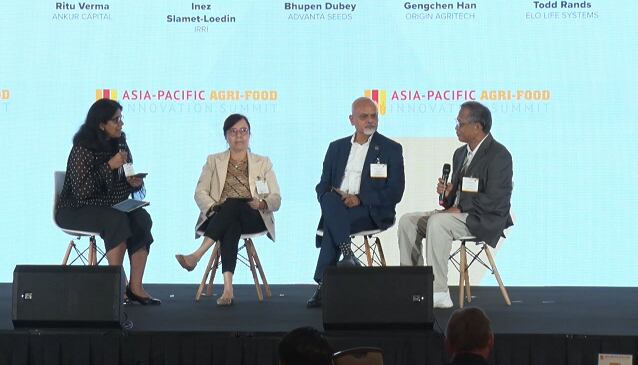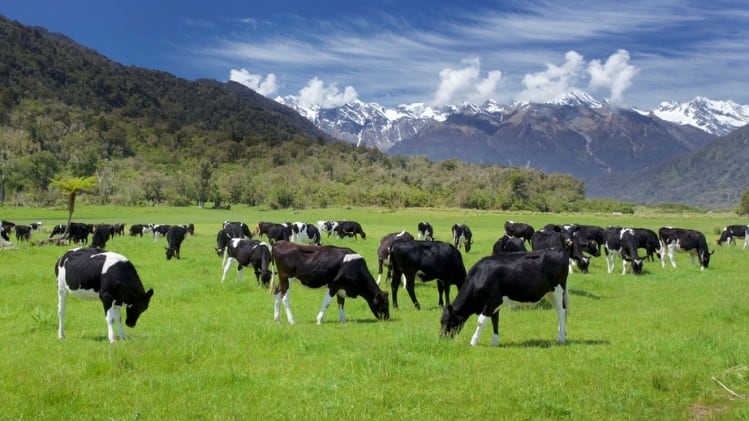This is according to a panel involving International Rice Research Institute (IRRI), Advanta Seeds, and Origin Agritech, which discussed the topic 'The Role of Biotechnology in Achieving Food Security' during the second day of the Asia-Pacific Agri-Food Innovation Summit 2023 in Singapore on November 1.
The panellists involved Inez Slamet-Loedin, head – Rice Genetic Design & Validation Unit, IRRI; Bhupen Dubey, global CEO of Advanta Seeds; and Gengchen Han, chairman of Origin Agritech. The panel discussion was moderated by Ritu Verma from Ankur Capita.

Kickstarting the discussion, Han pointed out that biotechnology’s use in agriculture has made significant progress in the last 30 years with the advent of GM products which has progressed to gene editing.
Soybean is one of the crops that is most impacted by the GM technology, with countries that are not traditional producers of soybeans being in the position to breed the crop and becoming a major exporter today. One such examples is South America, said Han.
Another benefit of the GM technology is to allow crops become insect resistant.
However, GM organisms (GMO) are still facing resistance form the public to this day and it is costly for small and middle enterprises to adopt the GM technology.
Gene editing, on the other hand, will offer much more promise in the next 10 to 20 years, Han believes.
“Gene editing is a more promising technology in increasing productivity and crop yield… Maybe gene editing will become a more common technique used by breeders,” Han pointed out.
One of the reasons is because it costs much less than the GM technology and could be used on more crop varieties.
Having worked with the GM technology since 2003, his company dabbled into gene editing in 2016 and has been building the gene editing pool to achieve traits such as disease resistance and improving yield in the last two years.
Gene editing possibilities 'immense'
In the same vein, Dubey said that the opportunities for the gene editing technology to scale in Asia is “immense”.
One of the reasons is because food demand is fast outpacing supply and so the adoption of biotechnology can be massive in Asia.
Across the world, the four crops dependent on the GM technology are corn, cotton, soybeans, and canola. Of which, the first three have a high consumption rate in Asia.
In fact, investments are ready to be streamed into biotechnology’s use in agriculture.
However, because agricultural is a way of living in many parts of Asia and companies need to take note of the political and cultural sensitivities, the return in capital in Asia could still be tough.
“The investments are also looking to come into this area…The only thing is that seed companies like us must get the equation of risk reward and cost benefit right,” he said.
Han held the same view, pointing out that agriculture and biotechnology would usually take years to reap returns, and the commercialisation process is usually slow.
Slamet-Loedin, on the other hand, said that IRRI has been increasing using gene editing to introduce beneficial traits, such as disease resistance in rice varieties popular in the developing countries.
Similarly, she pointed out that the advantage of gene editing laid in its low cost of investment.
“I think the advantage is that the investment [in gene editing] is not as big as GM,” she said at the panel discussion.
Hurdles to overcome to attract investments
Speaking to AgTechNavigator, Dubey pointed out that the adoption of biotechnology in agriculture would require acceptance at three levels.
They are namely acceptance at the consumer level, government level, and then at the investors level.
“Investors need a return of their investments, and so the adoption of biotechnologies require acceptance at three levels.
“One is the consumer level. They must perceive a need for that technology and all the benefits that this technology brings in. That is the starting point.
“The governments in various countries will then respond positively and set in place regulatory mechanisms.
“Once these two things are achieved, then I think the investors will come into play.”
He said that Asia remained a price-sensitive market and the farmers were usually the smallholders. In this case, biotechnologies need to be made available to them at an affordable price. To achieve affordability, he believes that the technology provider must play a role. This includes spreading the technology in terms of the number of farmers and farmlands using the technology.
“The important part is sustainability and the benefits which it brings in. If the investors are ready to look at those sustainable benefits [of biotechnologies], then I think the equation can change to become more favourable.
“The farmers will also need to know the benefits of using the technology, such as increasing productivity so that they do not need to bring more area for agricultural activities, since the same amount of land, water, and fertiliser can produce more.”
Regulatory hurdles to overcome
Currently, gene editing is regulated similarly as conventional breeding in certain parts of Asia.
However, the regulatory acceptance remains low, with India, Philippines the few countries that have established regulations for gene editing products, Slamet-Loedin told us.
Gene edited products need to show that there is no presence of foreign genes from other species or insects to the regulators and they could be accepted as a product from conventional breeding.
“I support this method, but in certain countries, it's not clear as to what is gene editing – is it going to be classified as GMO or non-GMO?
“In many Asian countries, there is no regulation for gene-editing yet, except for Japan, India, Philippines which are examples of Asian countries which are regulating gene-editing as non-GM if companies can show that the products are non-GM.”
She believes a harmonised set of regulations will help simplify trade.
Gene editing largely mimics what happens in the nature and hence, is more accepted, she claimed.
“There are no added genes from foreign species in gene editing. You only edit the genes of the plant itself, it's not adding of foreign genes, and so people are not too worried and gene editing generally mimic what is happening in the nature,” she said, referring to gene mutation happening in nature.





